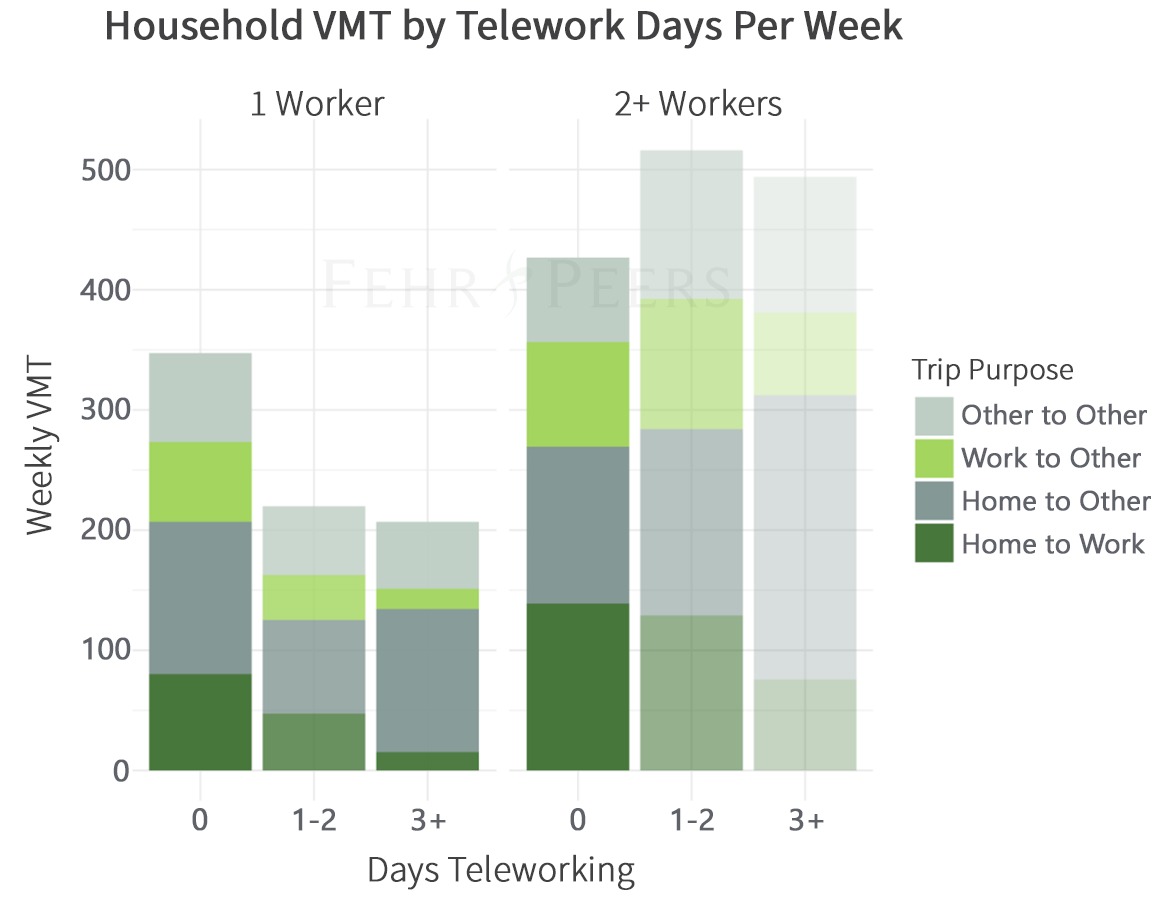Telework and VMT
Does working from home really make us drive less?
During the COVID-19 pandemic, most of us cut back or completely rid ourselves of the office commute. Rather than filling up and driving across town, we might only need to walk from the kitchen to our home office setup to start the workday. Common sense would tell us that skipping this commute to and from the workplace over a period of years would significantly reduce overall driving. Does the data, however, reflect that assumption?
This article examines the relationship between telework and vehicle miles traveled (VMT). Telework is the practice of working from home, a satellite office, or a shared space rather than commuting to a physical office. For purposes of this study, a telework day required the worker to telework for 6 hours or more and not travel to their primary workplace. Other work-related travel, however, could occur. Vehicle Miles Traveled (VMT) is used in transportation planning to determine the number of miles traveled by all vehicles in a geographic region over a given time period.
What does analysis tell us?
Comparison data for this investigation came from the Sacramento Regional Travel Study conducted in spring 2018. This household travel survey collected daily and weekly travel diaries from over 4,000 households and 8,300 people in the 6-county, SACOG planning region. The survey collected a variety of demographic and travel behavior data, including frequency of telework, and time spent teleworking.
Daily and weekly VMT were calculated both by worker and by household, and considered the following metrics:
-
-
- Household location
- Work location
- Commute distance
- Trip purpose
- Days of telework per week
- Whether worker has kid(s)
- Whether household has kid(s)
- Household income
- Number of workers in household
-
For this study, workers were defined as people aged 16 or older who reported working full-time. Workers whose jobs included driving or traveling were removed. The reason for the long list of variables is due to the nature of telework and how it may affect the travel of an entire household. While reducing an individual’s commute VMT appears obvious when it comes to telework, what workers and their household members do with the extra time is the critical question for determining the net effect on VMT.
VMT Outcomes Were Mixed
Telework produced mixed VMT outcomes which were largely dependent on the number of workers in the household. Other factors that influenced VMT included the number of telework days in the week, presence of kids in the household, and household income.
This chart shows the influence of telework days and number of household workers on full week VMT generation. The one-worker household pattern is clear with declining VMT as more telework days are added, but the effect diminishes after two days of telework. The pattern is different for two or more workers in the household where telework may increase total household VMT as new activities are substituted for time spent at a physical work location. The sample of households with two or more workers teleworking, however, was too small to draw a definitive conclusion.
| Factors | Telework is Effective to Reduce VMT if You: |
Telework may be less Effective to Reduce VMT if You: |
| Days per week | Telework 2+ days | Telework <2 days |
| Commute distance | Live far from work | Live close to work |
| Workers in household | 1-worker | 2+ workers |
Number of Days of Telework
• 1 day: Teleworking one day per week does not generate significantly less VMT than not teleworking.
• 2+ days: Teleworking two or more days per week may be an effective VMT mitigation strategy.
Commute Distance
• Living far from work: Teleworking (even only one day per week) may reduce VMT for workers who live further away from their workplaces. Even if some new activities occur close to home they are likely to involve much shorter distances than a long commute trip.
• Living closer to work: Workers who live closer to their workplaces, even when they telework four or more days per week, may replace work trips with other trips, resulting in little or no reduction in VMT.
Number of Workers in Household
• 1 worker households: When VMT is compared across entire households, teleworking reduces VMT.
• 2+ worker households: When compared across entire households, multiple-worker households may experience some increase in VMT due to higher levels of home-based trip making.
Household Income
• Household Income <$100k: Telework reduces VMT. This effect increases with more telework days per week.
• Household Income >$100k: Telework for one or two days increases VMT. Reducing VMT only occurred with three of more days of telework.
Takeaway
This analysis provides insights into telework effects on VMT reduction while also spotlighting that influencing travel behavior is always a little more complex than some policy interventions may suggest. See related article here.
Please reach out if you’re interested in statistical details. Learn more about VMT here.


